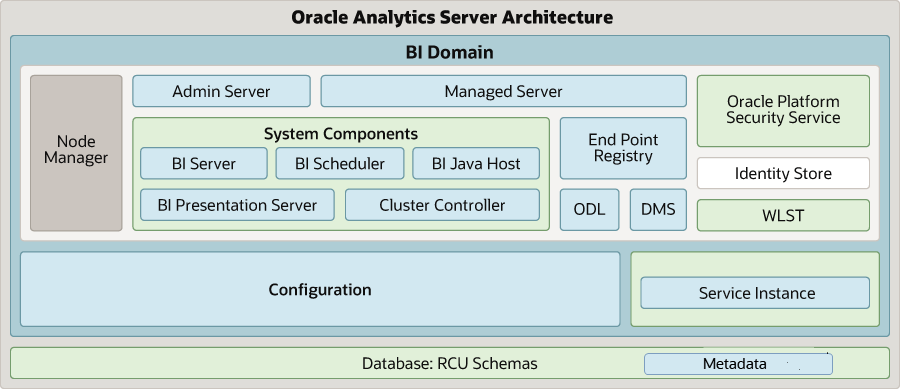What Is the Logical System Architecture?
The logical system architecture comprises a single integrated set of manageable components called the BI domain which can be installed and configured to work together on a single host or can be clustered across multiple hosts for performance and availability.
Note:
You can improve the performance of your production system by using a web server with the system such as Oracle HTTP Server or Apache HTTP Server. A web server isn't included by default in the installer and isn't part of the logical system architecture. You must install and configure a web server separately.This section contains the following topics:
Oracle Analytics Server System Architecture
You install Oracle Analytics Server on a single host, but can subsequently scale out onto additional computers.
The figure below illustrates the system architecture on a single host. See Oracle Analytics Server Components.
You install Oracle Analytics on a single host but you can scale out onto multiple hosts. Java components (WebLogic server domain) and system components are clustered on each host as part of the single BI domain. The Administration Server exists on both hosts, but is active on only one host.
Oracle Analytics Server Components
When you install Oracle Analytics Server, you can install several components in the BI Domain on the host.
The BI Domain consists of Java components that are deployed into one or more Java EE (JEE) containers within a single WebLogic server domain ; system (non-JEE) components and processes; and required configuration files, semantic models, and infrastructure.
-
Administration Server — Deployed as a JEE container that runs in a dedicated Java virtual machine that contains Java components for administering the system. These components include Oracle WebLogic Server Administration Console, Oracle Fusion Middleware Control, and JMX MBeans.
-
Managed Server — Deployed as a JEE container that runs in a dedicated Java virtual machine that provides the runtime environment for the Java-based services and applications within the system. These services and applications include Publisher, Presentation Services.
A BI domain contains one or more Managed Servers that are distributed across one or more host computers.
-
Node Manager — Provides process management services for the Administration Server, Managed Server processes, and System Components.
See Node Manager Overview in Administering Node Manager for Oracle WebLogic Server.
-
System Components — Deployed as server processes that provide the core services.
See About the Administration Server, Managed Servers, and System Components. For information about controlling system processes, see Process Control Commands.
-
Other Domain Contents — Includes all the necessary software, configuration files, metadata, WLST commands, security, and connection and database configuration information that are required to run the system.
For more information about:
-
Security configuration - See Managing Security for Oracle Analytics Server.
-
Metadata - See Manage Oracle Analytics Server Instances Using the WebLogic Server Scripting Tool and Managing Metadata Repositories for Oracle Analytics Server.
-
About the Administration Server, Managed Servers, and System Components
Oracle Analytics Server contains an Administration Server, Managed Servers, and system components which are described in this section.
See Getting Started Managing Oracle Fusion Middleware in Administering Oracle Fusion Middleware.
About the Administration Server and Managed Servers
The Administration Server and Managed Servers are Java components deployed as one or more Java EE applications and described in the following list:
-
Administration Server — Manages configuration and runtime settings for a single or multi-node (distributed) BI domain, using:
-
Fusion Middleware Control — An administrative user interface that is used to manage the BI domain.
-
WebLogic Server Administration Console — An administrative user interface that provides advanced management for WebLogic, JEE components, and security.
For more information, see What Are the System Administration Tools?.
-
-
Managed Server — Manages the following components:
-
Action Service — This component provides the dedicated web services that are required by the Action Framework and that enable an administrator to manually configure which web service directories can be browsed by users when they create actions.
-
Publisher — This component provides an enterprise reporting solution for authoring, managing, and delivering all types of highly formatted documents to employees, customers, and suppliers.
-
Security — This component provides dedicated web services that enable the integration of the Oracle BI Server with the Oracle Fusion Middleware security platform.
-
SOA Web Service — This component provides dedicated web services for objects in the Presentation Catalog, to invoke analyses, agents, and conditions. These services make it easy to invoke functionality from Business Process Execution Language (BPEL) processes.
-
Presentation Services — This component is a JEE application that routes HTTP and SOAP requests to Presentation Services.
-
About System Components
System components are deployed as non-JEE components, such as processes and services written in C++ and J2SE, and are described in the following list:
-
BI Server (OBIS) — This component provides the query and data access capabilities, and the services for accessing and managing the enterprise semantic model (stored in a file with an .rpd extension).
-
BI Scheduler (OBISCH) — This component provides extensible scheduling for analyses to be delivered to users at specified times. (Publisher has its own scheduler.)
-
BI JavaHost (OBIJH) — This component provides component services that enable Oracle BI Presentation Services to support various components such as Java tasks for Oracle BI Scheduler, Publisher, and graph generation. It also enables BI Server query access to Hyperion Financial Management and Hyperion Planning data sources.
-
BI Presentation Server (OBIPS) — This component provides the framework and interface for the presentation of business intelligence data to web clients. It maintains a Presentation Catalog service for the customization of this presentation framework.
-
Cluster Controller (OBICCS) — This component distributes requests to the BI Server, ensuring requests are evenly load-balanced across all BI Server process instances in the BI domain.
